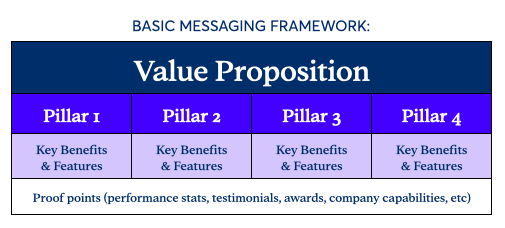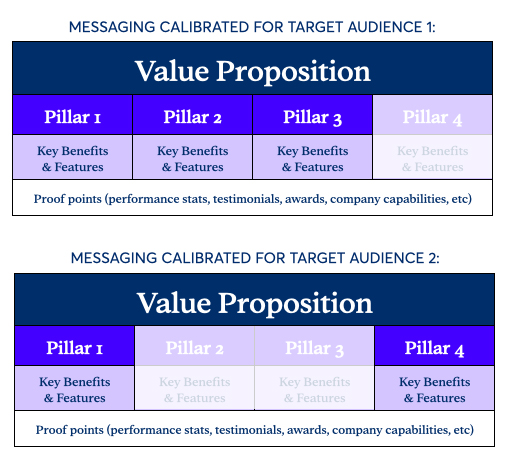
“Wealth is just consistency. I don’t want to be rich. I want to be wealthy.” – Quavo
Consistency isn’t sexy. It doesn’t turn heads or win awards. But, in the world of brands, consistency means clarity. Opportunity. A greater chance to make an impression and build a reputation.
This is particularly true with brand messaging. When messaging is consistent, it’s more likely to connect with the people you care about, helping build loyalty and drive sales. On the other hand, inconsistent messaging can confuse people, warp their expectations, or steer them to your rivals.
And yet brands often fall short in this department. In a joint study by InnerView & FocusVision, 43% of professionals surveyed were “highly confident that people throughout their organization can tell the company’s brand story accurately and consistently.”
Why? Because it’s hard.
Do you know your company’s brand story forward and backward? Could you tell it the same way every time, if you wanted to? Would it align with what your colleagues say, or your partners, or your customers? And why should you care?
A story consistently told is worth its weight in gold
A strong brand can be a source of pride, generator of buzz, a cultural touchstone. But it’s also a real asset with measurable equity – able to move units, raise prices, or reduce turnover for an organization.
One AdAge study talked with companies about whether their brand story is being told consistently across their organization. Among those who believe it is, “62% [said] the annual sales benefit is $10 million or more.” A related State of Brand Consistency report by LucidPress and Demand Metric found “the average revenue increase attributed to always presenting the brand consistently…is 23%.”
How can brand messaging consistency affect a bottom line? It can grease many spots in the sales pipeline, from driving awareness and interest at the top of the funnel to increasing conversion rates at point of sale. It also helps third-party partners, distributor partners, and influencers better serve as force multipliers, because they’re more likely to communicate your brand in an effective way.
Creativity may play in the field, but consistency works in the bank.
Biggest challenges: alignment, discipline, and some storytelling chops
On the flip side, brand messaging inconsistency comes with a cost, notably due to inefficiencies and missed opportunities.
Why does this happen?
Lots of reasons. Lack of interest. Lack of focus. Entrepreneurial types getting bored quickly. Executives switching things up for the sake of change. The need to say it differently for “this unique situation, just this one time”, but every time.
Part of the problem is alignment: Not everybody at the organization agrees with what to say and how to say it. Marketing hones messages that play in focus groups, while sales reps say “that’s not how it is in the field” and go rogue. Leadership has a polished story for investors and press, while everyday employees struggle to explain what the company does at the proverbial backyard barbecue.
And it’s not enough to just be consistent. Messaging should also be compelling, another area where many brands are sorely lacking. In Forrester’s 2021 B2B Brand And Communications survey, “only 23% [of respondents] felt very confident in their organization’s understanding of how to tell engaging brand stories.” Storytelling is a rare but valuable skill, one that takes guidance and practice.
These challenges aren’t insurmountable. But they do require some acknowledgment, discipline, and maybe a few special skills and tools.
How to make your messaging more consistent?
If you want to get more consistent with your brand messaging, your first step involves articulating it clearly and comprehensively in brand guidelines.
This is surprisingly rare. In virtually all brand guidelines, the design section dwarfs the copy section. Sure, they’ll hit core talking points, tone of voice, basic grammar styles. But copy guidelines usually have a check-the-box feel and lack the specificity they need to be truly usable. (There’s usually more direction around how to use secondary color palettes than how to write for a brand.)
So how do you convey your messaging more consistently?
1. Frame your messaging house
Elevate one main message (your value proposition) and three to five support messages (your messaging pillars) that hit the high notes, have a clear hierarchy, and rarely change them. Then support each messaging pillar with a handful of key benefits and features, for those situations that call for more substance. Finally, inventory any tangible proof points that may support any of the above – performance statistics, IP, customer testimonials, awards – these may come in handy later when you have time for in-depth messaging.
You know a strong and differentiated value proposition is critical. But to make your messaging consistent and scalable, the real secret sauce is in the messaging pillars: Some focused on products and services, others on addressing intangibles like customer support or company values. You want them simple but specific, benefit-led, and feature-supported. And they’re best when they’re mutually exclusive and collectively exhaustive.
2. Show how it can flex
Your messaging will ultimately be used by lots of different people for different reasons. To maintain consistency across the board, you want to keep it uncomplicated so it’s easy to remember, use and adapt as needed.
Your messaging will almost always lead with your value prop. After that, it gets tricky. What pillars to focus on, and in what sequence? That depends mostly on your target audience. A prospective customer might be served messaging focused on your offerings and service, while a prospective employee or investor may want more on company operations and values.
It also depends on your medium, and whether you have a little of your audience’s attention or a lot. An ad or elevator pitch may skim the surface, while a website or sales deck can go deep in select areas. The simpler the message map, the easier you can calibrate it per situation without reinventing the wheel.
3. Benchmark tone of voice
“Smart, yet humble.” “Innovative, yet human.” Most voice guidelines cover four to six adjectives; they’re often vague and aspirational, mostly fluff, and often contradictory. They’re also often paired with brand personas (don’t get me started on archetypes), another area that can be helpful but too often is overrun with marketingspeak.
Better to explain tone using examples of familiar brands, media, or people whose voice resonates (“Cerebral yet approachable, like The Atlantic or Neil DeGrasse Tyson”), so writers have reference material in a pinch. And don’t leave too much open to interpretation – descriptors like “smart”, “funny”, and “conversational” mean very different things to different people.
4. Share ample examples
Don’t be afraid to get specific. Share writing samples for different audiences and scenarios: A collection of headlines, paragraphs, and bullet points your people can grab in a pinch. Creative copy, elevator pitches, corporate communications, boilerplates, CEO speeches – writers like starter material, and they love getting it upfront.
Lay out ample do’s and don’ts. (People love do’s and don’ts; ever see the “logo usage” section of brand guidelines?) And be sure to distinguish between rules (“always do this, never that”) and recommendations (“do this when you can, such as A, B, or C”). It’s great to have both, just make it clear which is which.
5. Help your people own it
If you email people a PDF with 53 pages of brand rules, you know they’ll drop everything and read it cover to cover. Just kidding! If you want it to work, you’re looking at an internal launch with some training and fanfare. Host workshops, do a few practice runs, offer support, maybe throw in some incentives. You’re probably also equipping them with the tools and materials they need to deliver over and over again.
But if you’re looking for consistency, you’re playing the long game. A regular drip of internal communications and best practices. An ongoing recognition program that elevates employees who do a great job. (Who says you can’t have awards for consistency?) An open invitation to your team to share their thoughts and recommendations, or even vote new guidelines in (or out). When people actively co-create a brand, communicating it comes more naturally.
Brand messaging consistency isn’t sexy, but it pays
Messaging is just part of the bigger brand puzzle. You can’t talk your way around unclear target audiences, unfocused positioning, or an unreliable offering. A clear message can’t save a disjointed business or shallow brand.
But for companies with their house in order, the ability to communicate consistently helps to connect with people and cut through the clutter. It offers the chance to build brand equity and momentum.
“What needs saying is worth saying twice.” — Empedocles (ancient Greek philosopher, advanced brand messager)
Cover image source: Dil

